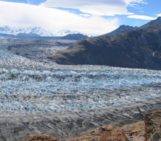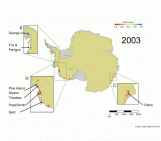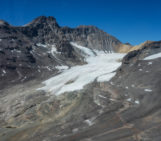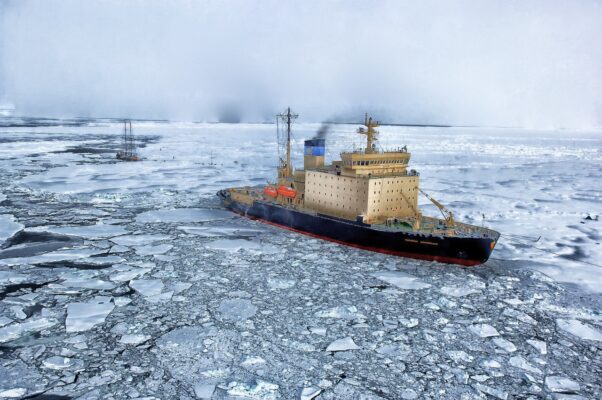
Increased maritime transport in the Arctic, facilitated by the reduction in sea ice cover, is causing tremendous harm to an already vulnerable part of the world. Insufficient regulation of Arctic shipping has detrimental environmental effects on a global scale. These effects include, e.g. underwater noise pollution, oil spill risk and threats to the global climate. But did you know what role regulation plays in this context? To answer this question, this post will shed some light on the topic of regulating black carbon emissions from Arctic shipping.
What do you think of when you hear the word ‘Arctic’? Do you think of cold temperatures, icebergs, polar bears and permafrost? While you might associate these things with the Arctic, your grandchildren and later generations might not. Temperatures in the Arctic have been rising for decades and at a rate of nearly four times as fast as the rest of the planet.
The effects thereof could inter alia have detrimental ecological impacts in the Arctic, affecting its characteristic wildlife, flora and fauna. And while it might already be too late to save some of these characteristics, such as Arctic sea ice in the summer (which, under some emission scenarios is projected to disappear by 2050; for more on Arctic sea ice read this post), a shift in focus on environmental and climate protection in the Arctic could help mitigate some of the worst climate change effects. One crucial area that needs our attention is the issue of Arctic shipping.
Arctic shipping
Shipping in the Arctic is becoming more and more popular as the Earth’s temperature rises and the period with open water (instead of sea ice) lengthens. This, in turn, opens up new shipping opportunities (see figure 2).
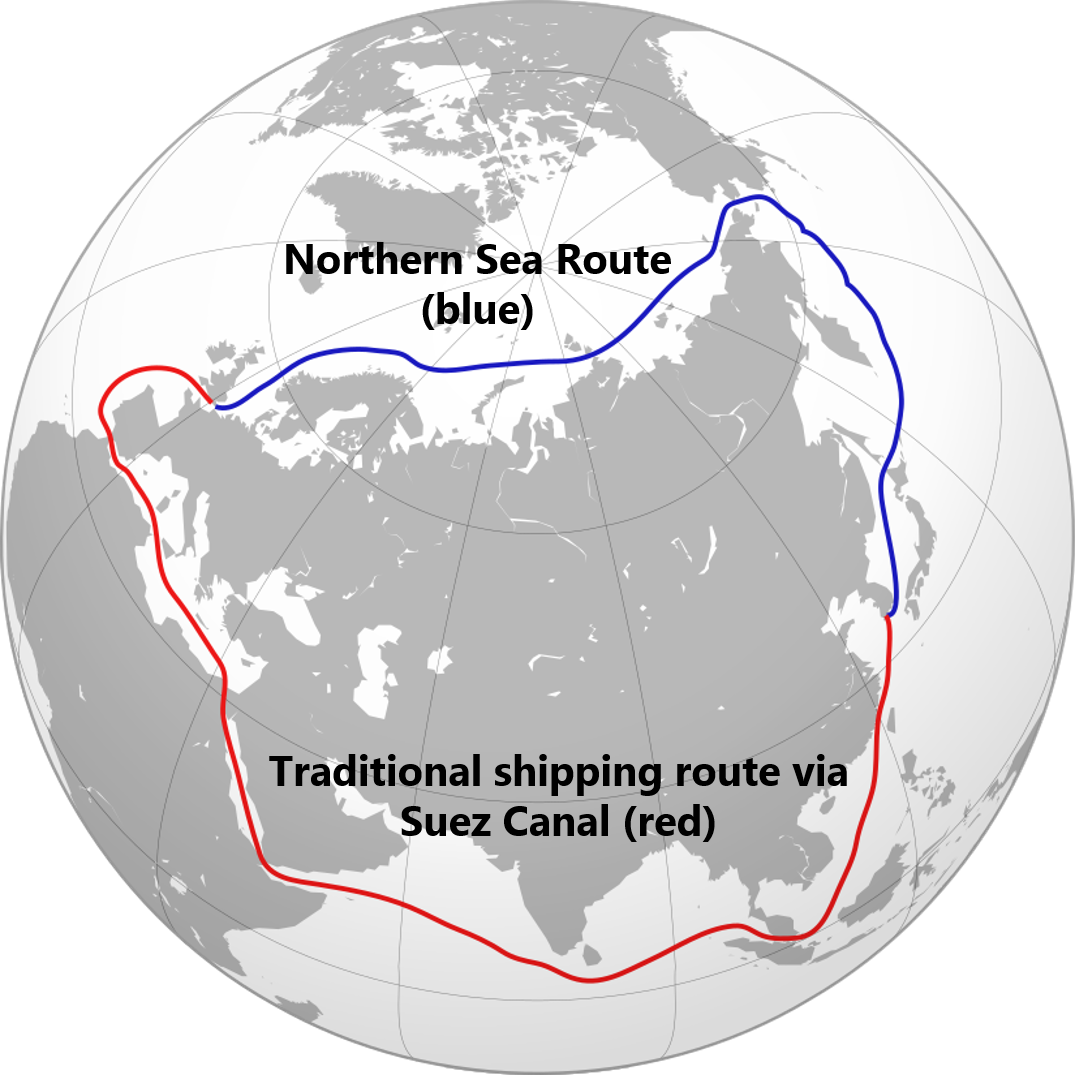
Figure 2: Northern Sea Route as compared to the Suez Canal Route. [Credit: Collin Knopp-Schwyn and Turkish Flame, via Wikimedia Commons ]
Lack of sufficient regulation
Shipping in the Arctic is not a problem per se, but the lack of regulation turns it into one, especially with the potential increase in traffic (read more about different types of regulation in the Arctic here). Although the international community has agreed to limit global warming through the Paris Agreement, it has, to date, neglected this promise in regard to the regulation of Arctic shipping.
This is especially tragic since the Arctic is not only particularly vulnerable to and affected by climate change, but also since emissions from Arctic shipping will increase even further as Arctic routes become more available for international transport, thus leading to even more warming and reduced sea ice, and so on (see this post for a visualization of this topic using a container ship).
As a recent report shows, the number of ships in the Arctic has, from 2013 to 2023 alone, increased by 37%, and the total distance travelled by these ships has grown by 111%. And it is expected to grow even further, thereby also increasing its emissions. Without any regulation, the result might well be detrimental climate-change effects.
The issue with black carbon
A big issue in this regard is lack of regulation on black carbon emissions from Arctic shipping. Black carbon (also called soot) is a fine air pollutant, which is emitted by ships burning Heavy Fuel Oil (HFO). This pollutant is of special concern in the Arctic because when it falls on snow and ice, it acts as a catalyst (accelerator) for rising temperatures on a global scale by lowering its albedo (read more about black carbon in the Arctic here).
Black carbon has been on the regulatory agenda of the International Maritime Organization (IMO), the UN body that regulates international shipping, for more than a decade. Recently, two legal developments finally came out of the IMO discussions. One of these legal developments is a resolution the IMO adopted in 2021 on a switch to cleaner fuels. This resolution, however, is strictly voluntary and does thus not impose any binding rules on states or the industry.
The other development is the IMO’s Arctic HFO ban. Interestingly, a stringent ban on the usage of HFO does exist in regard to Antarctica, which has similar climate conditions to the Arctic. In the Arctic, however, the ‘ban’ on HFO is extremely weak. Not only will it first be applicable after 1 July 2024; but, due to an array of exemptions, a complete ban on HFO in the Arctic will not exist until mid-2029. The International Council on Clean Transportation (ICCT) calculated that this ban would reduce black carbon emissions by only 5%. And this is the problem. Without proper regulation, shipping in the Arctic and the emission of black carbon will continuously increase within the next 6 years and beyond, posing an environmental threat not only to the vulnerable region of the Arctic but to the entire planet.
But why this lack of regulation
One factor that could explain the lack of regulation is the multitude of actors involved in the regulation of Arctic shipping. Although a mandatory switch to cleaner fuels might be favorable for some of these actors, others might not want this regulation.
Environmental groups and indigenous communities living in the Arctic have been specifically vocal, advocating strongly for strict and mandatory regulation on black carbon emissions from Arctic shipping (check out some of their submissions to the IMO here). Similarly, certain environmentally progressive industry actors would also welcome stricter regulation on this topic.
Actors that are less in favor of such regulation include, for example, certain other actors within the shipping industry, the energy sector and/or states with large shipping fleets. Members of the shipping industry, for instance, might be less in favor of switching to other, more sustainable, fuels due to potential switching costs. Furthermore, for some countries, such as Russia, these new routes can be extremely profitable (e.g. for accessing resources in the Arctic, or for receiving transit fees). These countries might thus favor a more unregulated system – prioritizing instead the quantity of ships passing through their waters and the new trade possibilities, regardless of which type of fuel the ships use.
The different actors involved in the regulation of Arctic shipping thus stand in conflict with each other, each having their own incentives and different bargaining powers at the law-making tables, making it difficult to find a consensus on Arctic shipping regulations – a consensus that is crucial to pass regulations at the IMO.
Need for better regulation
One way of ensuring better regulation of the climate change impacts of Arctic shipping would be to adopt a complete ban of HFO in the Arctic, such as in the Antarctic, as soon as possible, or to adopt a mandatory switch to cleaner fuels.
These are not the only regulatory options on the table, however. Over the years, the IMO has gone from a list of 41 options down to six. Next to fuel switches, these other regulatory options inter alia concern measures on engines, the installation of exhaust gas after-treatments (such as diesel particulate filters), which essentially remove the soot from a ship’s engine, and/or the designation of Emission Control Areas (ECAs). ECAs are special areas in the sea which the IMO can designate to adopt stricter emissions standards. A consensus on which option to go for has not yet been found.
The multitude of actors involved in Arctic shipping is making regulation on this topic difficult to get through. It is, however the task of the IMO and its members to overcome these issues and to regulate this matter in order to mitigate climate change and its global and regional effects. This way, the emission of black carbon in the Arctic will be halted and the Arctic environment and global climate protected.
Further reading
• A paper by Yamineva, Y., & Kulovesi, K. (2018). Keeping the Arctic white: The legal and governance landscape for reducing short-lived climate pollutants in the Arctic region.
• An ICCT report: Prevalence of heavy fuel oil and black carbon in Arctic shipping, 2015 to 2025
• A Clean Arctic Alliance Webinar Video: Urgent Need to Cut Black Carbon from Arctic Shipping
• Another blog post on Arctic regulations: “Did you know there’s a (relatively new) treaty for the Central Arctic Ocean?“
Edited by David Docquier and Lina Madaj
 A. Stella Ebbersmeyer is a PhD student at the Centre for Climate Change Law and Governance (CLIMA), Faculty of Law, University of Copenhagen. For her PhD she analyzes the different roles of the actors involved in the regulation of Arctic shipping, determining their incentives, the challenges they encounter in the law-making processes and potential synergies that they could form. The goal of this research is to help pave the way for the regulation of the shipping sector’s climate change related impacts in the Arctic. Contact her at stella.ebbersmeyer@jur.ku.dk.
A. Stella Ebbersmeyer is a PhD student at the Centre for Climate Change Law and Governance (CLIMA), Faculty of Law, University of Copenhagen. For her PhD she analyzes the different roles of the actors involved in the regulation of Arctic shipping, determining their incentives, the challenges they encounter in the law-making processes and potential synergies that they could form. The goal of this research is to help pave the way for the regulation of the shipping sector’s climate change related impacts in the Arctic. Contact her at stella.ebbersmeyer@jur.ku.dk.

